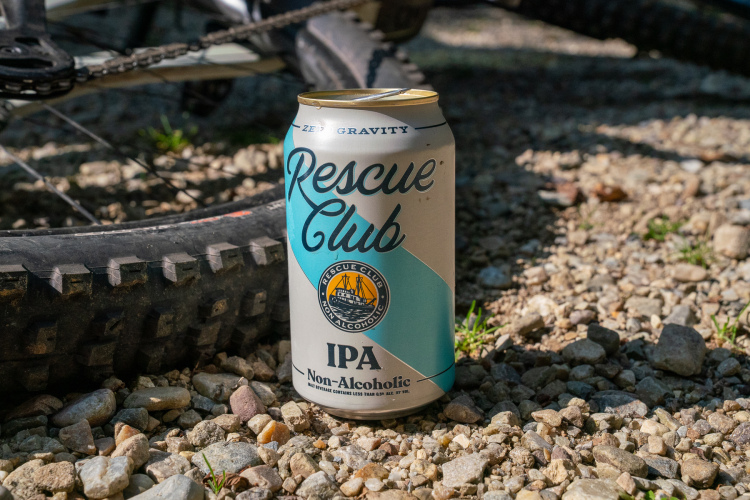
Near the end of spring, I broke my first mountain bike frame ever. With summer weeks away, I was bummed but confident, due to how my bike broke, in filing a warranty claim. But, what I thought would be an easy, reasonably black-and-white process had more gray areas than expected.
I was on a group ride, tackling beginner and intermediate trails. Our climbing trail, a blue that everyone agrees should be green, has one spot that barely pushes its way onto the “technical” spectrum. Two easy switchbacks wind the rider up through what most would consider a mellow rock garden.
Two or three more pedal strokes, and I would have cleaned the rocks. Instead, I stalled a bit, trying to track stand to set up for my next move. My track stand was unsuccessful, with my left pedal coming into contact with a rock. The rock held me momentarily, but my momentum was leaning left, and I chose to jump off the bike rather than fall.
Understand, this was at speed zero. The bike didn’t contact the ground as the handlebars remained in my hands. My hop off the bike was uneventful at best. Yet, as I hopped off, I heard a strange popping, cracking, scratching noise.
Immediately, I inspected the front triangle of my frame. I didn’t think it contacted the rock, but if it did, it would have been the front. I looked but saw nothing and chalked the strange noise up to my pedal, scarring the rock. It wasn’t until our ride ended, as I loaded my bike that I saw a hairline crack in the carbon on the seat stay.
It was a very uneventful way to break a frame. The bike was under a year old with no major crashes or impacts. So, I went to the bike shop to start the warranty process. I fully expected to be back on this bike within a few weeks. This, however, wasn’t the case.
Navigating The Warranty Process
After a few days, the bike shop gave me the bad news. The bike manufacturer denied my claim. Their reason—paint chips around the crack looked like rock impacts, which must have compromised the carbon, leading to the damage.
I explained that the paint chips were not from rock impacts but from when I removed the frame protection. But, it was ultimately their decision, and they landed on rock impacts.
And I didn’t blame them. The paint chips looked like they could have resulted from rock impacts. We exchanged several emails over a few weeks, and while they did offer a price for a crash replacement, I ultimately decided to go in a different direction. I had been thinking about a new frame anyway.
As a journalist with my toes in the mountain bike industry, my curiosity spiked. We’ve all heard rumors of those who have their mountain bikes covered in a warranty claim when it appears maybe it shouldn’t. Or, perhaps their claim should have been covered, but it was rejected. Why was this?
As I began to look at the rhetoric of some manufacturer’s warranty statements, I found they say a lot of the same things. And, while I could sift through some of it, I thought I might try to find someone that could help me understand what a mountain bike’s frame warranty really says. So, I contacted an attorney.
Interpreting legal-ese
To be crystal clear, in no way did I seek out an attorney for any sort of legal action. I never considered it and besides, I had already bought a new frame.
Questions lingered with no clear answers. Why do some claims get accepted and others don’t? Does the manufacturer have the final say? Can anything be done if your claim is rejected?
Attorney John Bang of Advocate Law lent me some of his time in my search for answers. Bang has no connection with the mountain bike industry and expressed that he isn’t an expert on warranty law. He freely shared his unbiased legal opinion on the documents I emailed him.
I found Specialized Bikes’ full warranty to send to Bang. I chose Specialized for a couple of reasons. First, it was simply an example of a typical frame warranty in the mountain bike industry. And secondly, Specialized is one of the largest mountain bike manufacturers in the world.
Ultimately, I hoped Bang could give some insight into parts of the warranty that answered my questions. As it turns out, it seems like the “manufacturer defect” bit is a pretty big deal.
Breaking down what a manufacturer’s warranty actually means
My denied bike frame warranty claim left me feeling that I had no say in the process. The manufacturer looked at pictures and concluded what must have happened. In the end, it was my word versus theirs.
Bang said it’s that way for a reason. “Warranties or insurances will always cover something very specific to give latitude to the one providing the warranty or insurance.”
This is why phrases like “manufacturer defects” are so crucial in warranty statements. They become the thing that is “very specific.”
“The issue for consumers is that all of the criteria are fact-specific and subject to debate. What is a ‘defect in materials’ and a ‘defect in workmanship?’” Bang questioned. “Those have to do with something like an industry standard of the materials and the workmanship. And how do you determine that a broken bike is due to one of these defects? It’s all gray.”
We can all think of cases where a manufacturer defect is evident. Shimano recently had one. But Bang wasn’t referring to the black-and-white issues. In my case, the bike broke from me dismounting, yet it didn’t fall into their specific instances. Even after I explained that the paint chips were from removing frame protection, they told me that even my shoe hitting the seat stay could compromise the carbon.
With that line of reasoning, you could argue that simply riding the bike can compromise the integrity of the carbon. If you think a decision is ridiculous and want it changed, can that happen? Bang didn’t see much hope.
“The only mechanism to actually enforce that is through the legal process,” he said. “Who is going to hire an attorney to do that?”
“The language is written in a way that is incredibly favorable to the manufacturer,” Bang said. Phrases like the ones Specialized and other bike brands make in their warranty, saying, “at Specialized’s option,” essentially mean that the manufacturer has the final say. If the claim is in a gray area, which so many are, the manufacturer determines next steps. “Basically, you have to meet exact criteria to qualify for coverage.”
Again, Bang acknowledged his lack of expertise within the bike industry. He stressed that he doesn’t think that the bike industry, or any industry for that matter, is out to pull one over on the customer.
“Generally, I think the language in limited warranties is similar across all industries. Manufacturer’s defect warranty is probably pretty standard and was probably developed in response to years of case law. The language probably standardized over time.”
Who Gets Covered?
So, why do some manufacturers cover frames that aren’t defects while others aren’t? Bang took a guess.
“So it seems like the process is hopeless for consumers, or just based on luck because the outcome depends on the whims of whoever is responding to your emails/calls,” Bang said. “Or the company may choose to replace, not because they are for sure required by the warranty, but because it’s a good business decision.”
In my case, the company eventually covered my broken rear triangle. I believe my claim was approved because of this last reason. After several emails, one including a picture of the paint-chipped frame protection I peeled off (it was stuck under the seat of my car), they sent a new rear triangle. I appreciated them coming to that conclusion, but nearly four weeks passed, and I already purchased and was riding a new bike.
Understanding the Other Side
With all that said, working in warranty claims for any company is not a job I would want. I don’t fault the company that rejected my claim. They were making the best decision they could based on the information they had. That information was limited to my story and a few pictures.
It isn’t unreasonable for companies to protect themselves. People will take advantage. They took advantage of REI, which changed their return policy from the lifetime of a product to one year back in 2013. Outdoor gear products, especially bikes, can and do break.
It feels good to see the words “Lifetime Warranty” when considering handing over thousands of dollars for a new mountain bike. But don’t forget, that warranty usually comes with an asterisk.








11 Comments
Nov 13, 2023
Nov 13, 2023
Nov 13, 2023
Nov 13, 2023
On the opposite side. I had a faulty rubber O-ring in a Topeak pump. I contacted Topeak to see if I could buy a new o-ring. They asked fir my address and said they'd take care of me. I was expecting that they would send me a new o-ring, but was surprised a few weeks later to have a new top of the line pump arrive on my doorstep. That was just over 20 years ago and ever since I have been a loyal Topeak customer.
Nov 13, 2023
In the case of a warranty denial, it's likely the brand has determined they will lose money on the transaction. However, I wonder how often they also consider the loss of future sales from the customer. In business there's the idea of firing your worst customers, and most bike brands likely do this from time to time.
Nov 13, 2023
Nov 13, 2023
Nov 14, 2023
Nov 16, 2023
Nov 18, 2023
Nov 17, 2023